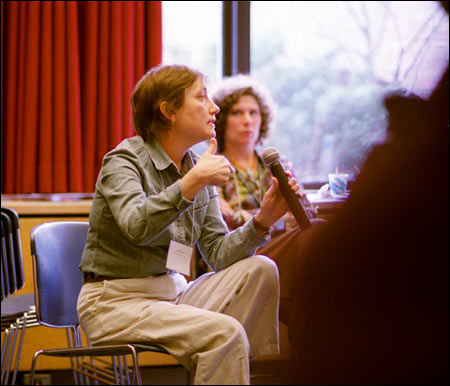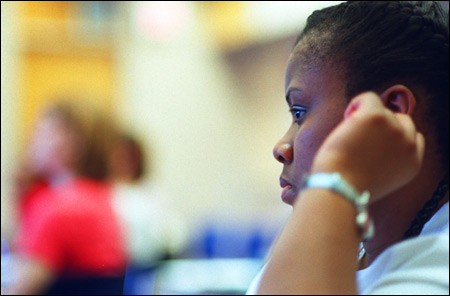Is it hormones or a hazard?:
Harvard workshops help Boston, Cambridge after-school programs understand adolescent mental health

Adolescence, that betwixt-and-between age that bridges childhood and early adulthood, can be more than just awkward years of peer pressure, raging hormones, and changing identities. Those early teen years can be downright dangerous, as risk-taking behavior meets poor judgment with disastrous or even deadly outcomes.
After-school education similarly occupies a betwixt-and-between space, one that’s neither the formal learning environment of school nor the unstructured time of home and family. Because of the unique role it plays in young adults’ lives, after-school programs present opportunities for addressing adolescent mental health concerns. Yet the complex emotional and behavioral issues of adolescents pose challenges to after-school programs.
To help after-school providers in Cambridge and Boston meet these challenges, several Harvard research centers and initiatives have partnered with Boston Mayor Thomas Menino’s 2:00-to-6:00 Initiative for a series of workshops for after-school programs directors, staff, youth workers, and tutors.

“The project was developed in response to what we heard were some of the most salient topics in socio-emotional well-being and mental health in after school,” says Susanna Barry, program manager for the workshops and assistant director of the Program in Afterschool Education (PAER) at the Graduate School of Education. PAER is collaborating with McLean Hospital and the Harvard After School Initiative (HASI) to coordinate these workshops.
Mental health issues rank among providers’ top priorities, says Barry, because left unchecked, they undermine after-school programs’ more creative initiatives. “Figuring out the socio-emotional and mental health piece is the gateway to being able to do more innovative programming,” she says.
Under the series title of “Working With All Children in Afterschool Programs: Reducing Risk, Increasing Resiliency,” the four workshops this spring focus on adolescent mental health in particular. Four more workshops this fall will address issues faced by younger children.
Normal risk-taking or deadly behavior?
At a workshop on Wednesday (April 16), the second in the spring series, Karen Hacker, executive director of the Institute for Community Health at the Cambridge Public Health Department, shared her insights on adolescents and their risky behaviors with 35 after-school providers.
“Risk during adolescence is part of growing up, learning about who you are, trying on different hats and deciding, ‘Does this one fit?’” she said. Not all risk is bad, she stressed, yet other emotional hallmarks of adolescence, such as peer pressure and short-term, self-focused thinking, can make risk-taking dangerous. Motor vehicle accidents, homicide, and suicide are the leading causes of death among adolescents, she said. Drug and alcohol abuse and risky sexual behaviors are other dangers, which often correlate with each other.
“The same kid who is smoking is probably having unprotected sex and ditching out on school,” said Hacker. “These things tend to come in clumps.”
For adults, understanding adolescents’ hormonal roller-coaster ride and teasing healthy experimentation from potentially dangerous risk-taking can be a daunting task. “When do I intervene? When is it normal? When is it something I should worry about?” said Hacker.
Hacker presented classic stages of adolescence and physical and emotional benchmarks by which after-school providers (or parents) can assess risky behavior. Not surprisingly, poverty and family dysfunction and instability are major indicators of risky behavior, as is the age at which risk-taking occurs.
“The earlier things happen, the more we are concerned about them,” she said. “Why is a 10-year-old doing drugs?”
Case studies meet real-world experience
Hacker presented three cases for the group to discuss; the providers brought their wisdom and experience from the front lines of after-school education to bear.
Participants dove into the cases of a 15-year-old caught smoking pot at school with older boys who “made him do it,” a 16-year-old girl who couldn’t tell her mother she was having sex, and a 16-year-old boy who’s depressed.
“I see this all the time in my center,” said one provider of the pot-smoker whose mother works two jobs and who doesn’t know who his father is. “No one’s watching this child.”
Citing research that shows the protective effect against risky behaviors of just one caring adult in a child’s life, Hacker underscored the potential for after-school providers to play that role.
“You guys are really important in these kids’ lives,” she said, adding that it is also crucial – and difficult – to draw appropriate boundaries with needy youth and to know when and how to seek out additional services.
Providers also discussed cultural challenges they face in serving a multicultural population. Values and expectations may vary from provider to student and even from one student to another. For some immigrants, for instance, teen pregnancy may be the norm in their countries of origin.
After the two-hour workshop, participants lingered to swap stories with each other and probe Hacker with their questions.
“I think when you combine people’s experiences with a speaker, you get more perspective,” said Kate Perez of the East End House in East Cambridge. She praised Hacker’s research-based approach to decoding adolescent behavior. “When you break down things that you see every day and articulate them, you can see solutions,” she said.
Barry notes that such opportunities for professional development and peer discussion are important – and rare – in the emerging field of after-school education. One role PAER and these workshops play, she says, is gathering information and sharing it among those who can most use it.
“While an individual program in Boston may know that it is seeing a lot of fighting on the basketball court, we can see that that happens in hundreds of programs in Boston and Cambridge all week long,” she says. “We’re able to take that bird’s-eye view.”




